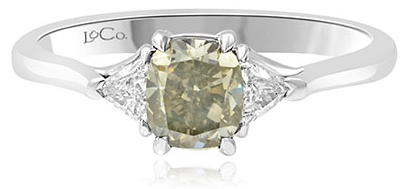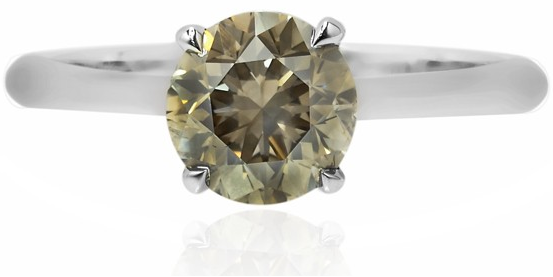Натуральные фантазийные серые бриллианты
Природные серые бриллианты, как и все цветные алмазы, получают свой цвет от вкрапления посторонних элементов во время формирования алмаза под землей. В этом случае серый цвет вызван вкраплением водорода, хотя он также может быть вызван бором. Несмотря на это, эти бриллианты бывают самых разных оттенков, что и придает им их очень уникальный цвет. Серые алмазы иногда называют угольно-серыми, стальными, сланцевыми, серебряными и голубиными и имеют мало интенсивности. Их тона варьируются от оловянных и никелевых до более глубоких оттенков, таких как графит и свинец. Серые алмазы добываются в Индии, России, Бразилии, Южной Африке и Австралии, где находится рудник Аргайл. Производство серых алмазов составляет 2% от его цветных алмазов (большинство из них-бриллианты цвета шампань), хотя они известны своими розовыми бриллиантами. Интересно, что серые алмазы, как и голубые, являются полупроводниками электричества-в отличие от большинства алмазов, включая большинство цветных и бесцветных, которые не являются проводниками.

Фантазийные серые круглые бриллиантовые серьги-гвоздики весом 1,10 карата
Серый как основной или вторичный цвет
Его уровни интенсивности цвета-светло-серый, фантазийный светло-серый, фантазийный серый, фантазийный темно-серый и фантазийный глубокий серый. Цвета алмаза кажутся более холодными или теплыми в зависимости от того, содержат ли они более холодный синий или зеленый, или более теплые коричневые и желтые цвета.

Шкала интенсивности серых бриллиантов, от самого светлого (слабый серый) до самого темного (фантазийный темно-серый)
В зависимости от того, как они установлены в ювелирных изделиях, темнота или светлость алмаза может быть более или менее выражена. Окружение его бесцветными бриллиантами действительно позволяет бриллианту сиять больше всего и занимать центральное место, особенно если в центре бриллианта присутствуют вторичные цвета.

1,01 карата фантазийный серый бриллиант огранки кушон и треугольное бриллиантовое кольцо
Серый цвет появляется как вторичный цвет в основном в зеленых и синих бриллиантах, но также может быть найден в желтом, хамелеоне, фиолетовом и пурпурных цветах.

2,01 карата кольцо с фантазийным темно-зеленовато-серым бриллиантом-солитером
Знаменитые серые бриллианты
Бриллиант надежды, самый знаменитый бриллиант в истории, официально считается фантазийным серо-голубым. Нет знаменитых серых бриллиантов, поскольку они не были исторически популярны, но некоторые из самых известных голубых бриллиантов в мире имеют официальное цветовое обозначение "серовато – голубой" - в том числе знаменитый бриллиант надежды, султан Марокко и бриллиант Виттельсбаха.
Бриллиант Надежды
Бриллиант надежды (ранее "Le bleu de France") - самый большой темно-синий бриллиант в мире. 45,52-каратный (9,10 г) фантазийный глубокий серовато-голубой алмаз VS1 был добыт в Индии, и его размеры составляют 25,60 мм (длина) × 21,78 мм (ширина) × 12,00 мм (глубина).
Легенда гласит, что первоначальная форма бриллианта Надежды была украдена
из глаза скульптурной статуи богини Ситы в индуистском храме. Затем жрецы храма
наложили проклятие на того, кто мог обладать пропавшим камнем, и родилось
“проклятие” бриллианта надежды.Бриллиант надежды и связанное с ним проклятие
впоследствии были использованы среди прочих смертных случаев, в обезглавливании
Людовика XVI и Марии-Антуанетты. Сентябрь 1812 года-это самый ранний
момент, когда история бриллианта надежды может быть окончательно установлена.
Голубой бриллиант той же формы, размера и цвета, что и бриллиант Надежды, был
записан во владении лондонского торговца бриллиантами Дэниела
Элиасона. Бриллиант надежды появился в 1839 году в опубликованном каталоге
коллекции драгоценных камней известного британского банкира Генри Филипа Хоупа,
который умер в том же году. Его старший племянник, Генри Томас Хоуп,
унаследовал бриллиант Хоуп. После дальнейших проблем с наследством и
многочисленных изменений в собственности, бриллиант надежды, наконец, попал в
руки торговца алмазами Гарри Уинстона в 1949 году. 10 ноября 1958 года Уинстон
передал бриллиант в дар Смитсоновскому институту. Традиционно бриллиант
надежды находился в колье, выставленном в Смитсоновском институте в овальной
оправе, окруженной серией белых бриллиантов; однако в 2009 году он был
выставлен как свободный драгоценный камень. 18 ноября 2010 года бриллиант
Надежды был показан в новой оправк, причем дизайн был выбран из трех возможных
в онлайн-голосовании более чем 100 000 человек. Бриллиант Надежды был
показан в этой оправе в течение года, прежде чем был возвращен в свою
традиционную оправу.
Бриллиант Виттельсбах-Граффа
Виттельсбах был 35,56-каратным фантазийным глубоким серовато-голубым бриллиантом VS2, ограненным с необычным рисунком из 82 граней. Поскольку Мадридские архивы были уничтожены во время Гражданской войны в Испании в 1936-1939 годах, самая ранняя запись о бриллианте датируется 1664 годом, когда он был подарен Филиппом IV своей дочери Инфанте Маргарете Терезе, тогда 15-летней, для ее помолвки с императором Австрии Леопольдом I. В 1675 году в молодом возрасте 21 года Инфанта умерла, будучи ослабленной слишком большим количеством выкидышей. Ее муж унаследовал все ее драгоценности и, в свою очередь, оставил их своей третьей жене, императрице Элеоноре Магдалене, которая передала большой голубой бриллиант своей внучке, эрцгерцогине Марии Амелии.
В 1964 году он был куплен частным коллекционером, а в 2008 году бриллиант Виттельсбах был продан на аукционе Christie's знаменитому ювелиру Лоуренсу Граффу за 24,3 миллиона долларов. Графф заново огранит бриллиант, потеряв 4,45 карата, до 31,06 карата, "чтобы удалить повреждение рундиста и усилить цвет.” Теперь это фантазийный темно-синий IF (внутренне безупречный).
Султан Марокко
Огранка кушон, 35,27 карата, фантазийный серовато-голубой султан Марокко имеет неизвестную чистоту. Считается, что алмаз вышел из Индии в середине 19 века, однако как он попал в Европу, за сколько, предыдущий владелец и тому подобное неизвестно.
Это название наводит на мысль о возможной связи с правящими семьями Марокко-султанами, однако доказательств этому нет. Бриллиант определенно находился во владении семьи Юсуповых, Русского дворянского рода татарского происхождения, в 1840 году. В 1922 году князь Феликс Юсупов, последний Юсуповский князь и наиболее известный своей непосредственной причастностью к убийству Распутина, продал бриллиант Cartier в Нью-Йорке. В 1972 году алмаз был продан частным образом анонимному покупателю в Сан-Франциско, штат Калифорния, за 250 000 долларов США. Покупатель, по-видимому, был связан с вице-президентом компании " Бад " Эресманом, которому знаменитый ювелир Лайкин доставил камень из Лос-Анджелеса, штат Калифорния.
Мы изготовим на заказ уникальные ювелирные украшения с фантазийными серыми бриллиантами на Ваш вкус! Спешите приобрести настоящее произведение искусства в нашем ювелирном магазине.
